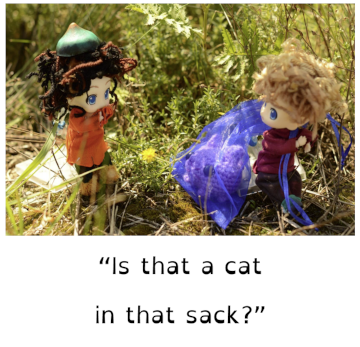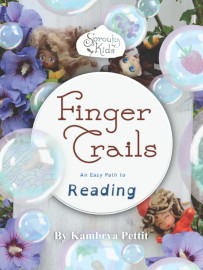Sprouty Kids is a playful reading program that is simpler to use than many others once you’ve got things assembled. It teaches phonics and reading skills beginning with the pre-reading stage and continuing through complex phonograms and multi-syllable words. Most of the program is printed in a dyslexic-friendly font.
The core of the program is Finger Trails: An Easy Path to Reading, available as a free, 206-page PDF or a printed book through Amazon. Finger Trails begins with a one-page summary of how the program works. A 15-page Table of Contents is presented in chart form, showing each lesson number followed by the phonics skills taught, the sight word to introduce, and the coordinating story in a reader.
The course instructions are presented in the next three sections: Reading Roots, Finger Trails How-To, and Sight Word Games. Reading Roots presents a six-step process for teaching pre-reading skills through discussion, reading aloud, letter cards, using optional alphabet letters (plastic, wood, etc.), and games. These lessons are entirely dependent on the parent selecting and presenting activities.
Step 7, Finger Trails How-To, explains how to use the finger trail pages that make up the bulk of this book. Finger trails, presented one per page, are like a game board path with letters, phonograms, phonetic nonsense syllables, or complete words on each step of the path. New phonetic elements are introduced at the top of the page along with a sight word for most lessons. Parents should go over these in advance, then have children follow the path, reading what is written on each step. The program relies on parents to teach the phonograms and words without much direction, but this shouldn’t be difficult.
Similarly, students concentrate practice on sight words when they come to pages with sight word slides instead of finger trails. At the bottom of many of the finger trail and sight word slide pages it says, “Practice what you just learned with this great book!”, and then identifies a story to be read from one of the readers.
The Sight Word Games section of the book consists of two pages with descriptions of 16 simple games that reinforce familiarity with sight words. You are encouraged to play one of these every day.
Along with Finger Trails, you also need the free set of printable Sight Word Cards that includes letters of the alphabet, four consonant digraphs (ch, sh, th, and ph), and words such as was, now, my, there, who, good, and because. (Some of the words can be sounded out phonetically once students have learned more phonograms.) The set also includes cards for number words (e.g., one, two, etc.), colors, days of the week, and months.
The PDF version of Finger Trails includes instructions to print the pages and place them in plastic sleeves. Then you put the Sight Word Cards in each plastic sleeve with the page that introduces each one. The plastic sleeves are put in a binder, and you should also get a zipper pouch where you can store mastered Sight Word Cards. If you purchase a printed version of Finger Trails, you might store the cards in a small file box. I like the idea of having the pages and cards together in the binder, so consider this when deciding which version of Finger Trails to use.
Optional Sprouty Kids Products
Readers
 For reading practice as students work through Finger Trails, you should probably purchase the Sprouty Kids ABC! and the 13 Sprouty Kids Progressing Reader Series books. Finger Trails lets you know exactly when children should use each reader. (You can use different sets of readers, but you have to figure out how to coordinate them.)
For reading practice as students work through Finger Trails, you should probably purchase the Sprouty Kids ABC! and the 13 Sprouty Kids Progressing Reader Series books. Finger Trails lets you know exactly when children should use each reader. (You can use different sets of readers, but you have to figure out how to coordinate them.)
The first reader is much shorter than the others at 31 pages and is used for practice identifying letters of the alphabet and words that begin with each letter’s sound. It might be skipped if a child already can identify the letters easily and is beginning to discern their sounds. The other 13 readers are sets of stories (called books), each 130 to 145 pages long. These books are heavily illustrated in full color with staged photos of miniature dolls with plastic and stuffed animals, plus other props as shown in the image. They are cute and creative!
The vocabulary is controlled, gradually becoming more difficult. However, the Sprouty Kids program introduces some words as sight words before students learn all of the phonograms. This enables them to read more interesting stories.
The Sprouty Kids website says lessons should take less than 15 minutes a day, but I think they might take a little longer if you are completing a Finger Trail Lesson, reading from a reader, and playing a sight-word game. Still, it’s not as time-consuming as many other programs.
Supplements
- 100 Alphabet Activities helps with pre-reading skills.
- Sight Word Picture Puzzles help children master sight words by identifying the correct words on a grid.
- To teach handwriting, you might add Short & Easy Handwriting Practice. This 146-page beginning handwriting course teaches printing by having children trace and then print on their own.
- Spelling: Phonics Word Searches has students practice spelling skills by completing word search puzzles.
- 100 Days in the Life of ____ (write in the child’s name on the line) is a picture journal where students can draw and write.
These books are available either as PDFs or printed books through Amazon.
Summary
Sprouty Kids makes the two key components—Finger Trails and the Sight Word Cards—available for free. The primary cost is for the readers and any supplements you might use. While you can substitute other readers, those from Sprouty Kids are unique and likely to engage students’ attention.



















